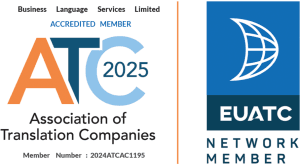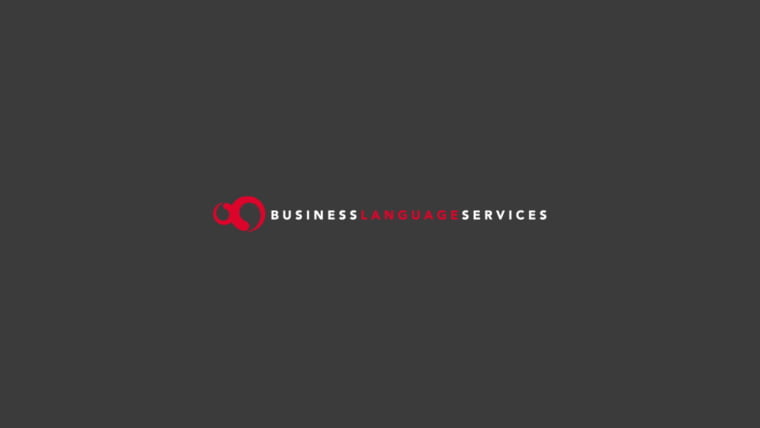Ever wondered what goes into producing a certified translation? What does the certified stamp signify? What do the different certification types mean? Why do I need to have my translation certified? Read on to find out everything you need to know about our certified translation services.
At Business Language Services, we have over 30 years of experience producing certified translations for many different documents, purposes and language combinations. In this article, we will outline the process of certifying a translation, explore the various types of certification available, and explain why certified translations are required.
What is a certified translation?


A certified translation contains a stamp from a recognised translation industry organisation, and the translated document is accompanied by a declaration from the translator or translation company, which provides a legally binding guarantee that:
- The translator is sufficiently qualified and experienced
- The translation is a true and accurate representation of the original document
- The translated document may be legally relied upon
Only an accredited linguist or translation company may certify a translation, meaning that they must be a member of a recognised translation industry association. The three such bodies in the UK are the Association of Translation Companies (ATC), the Institute of Translation and Interpreting (ITI), and the Chartered Institute of Linguists (CIOL). Business Language Services is an Accredited Member of the ATC and a Corporate Member of the ITI, and many of our linguists are also members of one or more of these associations in their own right. You will see our ATC stamp on all our certified translations.
In addition to being entitled to certify a translation, there are also various legal requirements for how a translation should be certified. For example, some circumstances require the declaration to be signed by the translator, while others accept the declaration signed by a representative of the translation company. Additionally, some authorities require higher levels of certification, such as notarisation or apostille, which we will explore in a separate article.
Documents whose translations frequently need to be certified include:
- Personal documents, e.g. birth certificates, death certificates, marriage certificates, identity documents, etc.
- Academic certificates, e.g. degrees, diplomas, transcripts, etc.
- Police / criminal record certificates
- Legal papers, e.g. contracts, divorce certificates, court reports, documents being used as evidence in court, etc.
Any translation errors in these documents could have serious legal implications in the situations in which the translation is to be used. As a result, certifying the translation gives the organisation or authority receiving the translation a guarantee that the translation is accurate, contains no errors, and was produced by a qualified, experienced and reputable linguist.
The process of producing a certified translation
1. Consultation
We discuss your request with you, including the purpose for which you need the translation, and advise you on the type of certification you are likely to need.
2. Quotation
We analyse the document(s) to be translated, assess the word count, and prepare a quote tailored to your project’s requirements.
Once you have made your payment, we can get the translation underway.
3. Translation
Our expert linguist translates your document(s) into the required language. All our linguists translate exclusively into their native language, to ensure the best possible quality.
4. Formatting
As well as translating the text, the translator may also need to manually recreate the layout and formatting of your documents, if they were sent as scans or photographs.
5. Revision
A second, equally qualified and experienced linguist revises the translation, checking for accuracy and fluency.
6. Proofreading
A member of our in-house project management team checks the translated file(s) for completeness and makes any final formatting adjustments.
7. Certification
Our project manager prepares and signs the declaration, and stamps the translated document(s) with our ATC stamp.
8. Delivery
Your certified translation is returned to you as a scanned copy initially, so that you can confirm that you are happy with it.
Once you have confirmed that everything is in order, we post the hard copies to you by 1st-class post.
Quality assurance and certification
Since the certification is a legally binding declaration that the translation is accurate, certified translations must be thoroughly revised and proofread to ensure that there are no errors whatsoever. Therefore, all certified translations are checked by three separate linguists – the original translator, a second, equally qualified and experienced reviser, and an in-house project manager (all of whom are also qualified linguists). At each stage of the process, extensive checks are performed to identify and rectify any possible errors in the translation and ensure that it is a faithful representation of the original document. This is backed up by our ISO 9001:2015 Quality Management certification.
Common challenges in certified translation
Every translation project presents a unique set of challenges, but certified translations have some particularly common challenges that can increase the amount of time they take to produce compared to, for example, business translations.
Handwriting
Many documents that require certified translation contain handwritten text – most frequently birth, marriage and death certificates. This can cause legibility issues and hence lead to an increased risk of spelling mistakes in the translation, particularly in people’s names. Therefore, if ever we are unsure about a piece of handwriting, we will always ask you to confirm what it says, so that we can ensure that the translated document is correct.
Illegible text and unclear scans/photographs
Most documents that require certified translation are in paper form. We are almost always able to work from a scan or photograph of the document and normally do not need to receive the original from you. However, particularly if the documents have been photographed, it is common for some text to be blurry, cut off or illegible. If this is the case, we will not be able to certify the translation and will need to ask you for a clearer copy of the source document. If you do not have access to a scanner or camera, you are always welcome to post the original documents to us or bring them to our offices in person, and we will be happy to scan them for you.
Translation to/from non-Latin script languages
We work with all languages spoken around the world, including rare languages and dialects. For languages that do not use the Latin alphabet – including, but not limited to, Arabic, Chinese, Greek, Hebrew, Japanese, Korean, Russian, Thai, Ukrainian, etc. – our linguists may need to transliterate (write in another script) the names of people and places mentioned in the documents. To facilitate this, it will be very helpful if you are able to provide reference documents showing how these names are spelt in both writing systems. This could be a passport or other government-issued ID and will allow us to ensure that they are spelt correctly in the translated document.
Why choose Business Language Services for your certified translation?
We have over 30 years of experience providing high-quality certified translation services, working with many different documents and over 500 language combinations. Our expert project management team are always on hand to answer any questions you may have and can advise you on the type of certification you are likely to need.
For more information or to get a quote, speak to one of the team today on +44 (0)29 2066 7666, by email at in**@*************************co.uk, or use our online quote form.
You can also find more information about the specific types of certified translations we offer here.
Author: Joseph Smith, Project Manager

